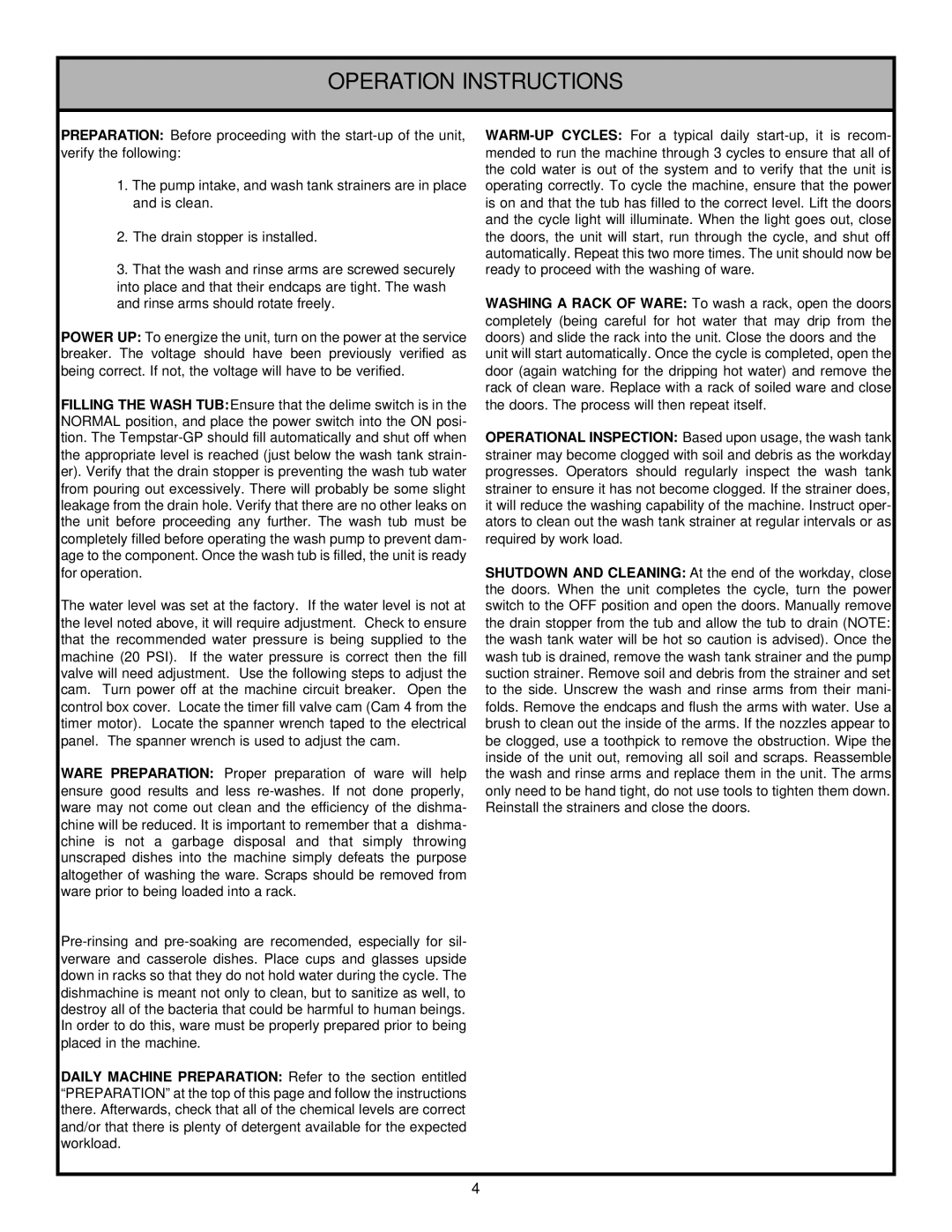
OPERATION INSTRUCTIONS
PREPARATION: Before proceeding with the
1.The pump intake, and wash tank strainers are in place and is clean.
2.The drain stopper is installed.
3.That the wash and rinse arms are screwed securely into place and that their endcaps are tight. The wash and rinse arms should rotate freely.
POWER UP: To energize the unit, turn on the power at the service breaker. The voltage should have been previously verified as being correct. If not, the voltage will have to be verified.
FILLING THE WASH TUB:Ensure that the delime switch is in the NORMAL position, and place the power switch into the ON posi- tion. The
The water level was set at the factory. If the water level is not at the level noted above, it will require adjustment. Check to ensure that the recommended water pressure is being supplied to the machine (20 PSI). If the water pressure is correct then the fill valve will need adjustment. Use the following steps to adjust the cam. Turn power off at the machine circuit breaker. Open the control box cover. Locate the timer fill valve cam (Cam 4 from the timer motor). Locate the spanner wrench taped to the electrical panel. The spanner wrench is used to adjust the cam.
WARE PREPARATION: Proper preparation of ware will help ensure good results and less
DAILY MACHINE PREPARATION: Refer to the section entitled “PREPARATION” at the top of this page and follow the instructions there. Afterwards, check that all of the chemical levels are correct and/or that there is plenty of detergent available for the expected workload.
WASHING A RACK OF WARE: To wash a rack, open the doors completely (being careful for hot water that may drip from the doors) and slide the rack into the unit. Close the doors and the unit will start automatically. Once the cycle is completed, open the door (again watching for the dripping hot water) and remove the rack of clean ware. Replace with a rack of soiled ware and close the doors. The process will then repeat itself.
OPERATIONAL INSPECTION: Based upon usage, the wash tank strainer may become clogged with soil and debris as the workday progresses. Operators should regularly inspect the wash tank strainer to ensure it has not become clogged. If the strainer does, it will reduce the washing capability of the machine. Instruct oper- ators to clean out the wash tank strainer at regular intervals or as required by work load.
SHUTDOWN AND CLEANING: At the end of the workday, close the doors. When the unit completes the cycle, turn the power switch to the OFF position and open the doors. Manually remove the drain stopper from the tub and allow the tub to drain (NOTE: the wash tank water will be hot so caution is advised). Once the wash tub is drained, remove the wash tank strainer and the pump suction strainer. Remove soil and debris from the strainer and set to the side. Unscrew the wash and rinse arms from their mani- folds. Remove the endcaps and flush the arms with water. Use a brush to clean out the inside of the arms. If the nozzles appear to be clogged, use a toothpick to remove the obstruction. Wipe the inside of the unit out, removing all soil and scraps. Reassemble the wash and rinse arms and replace them in the unit. The arms only need to be hand tight, do not use tools to tighten them down. Reinstall the strainers and close the doors.
4
